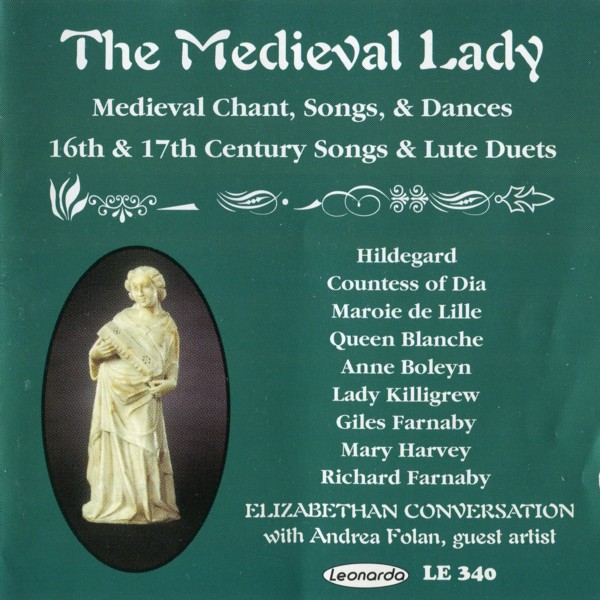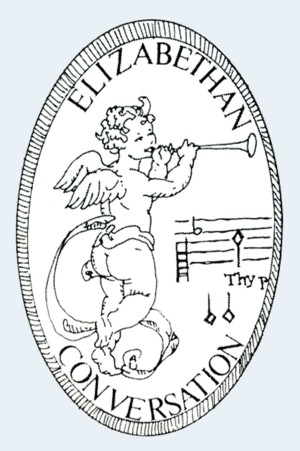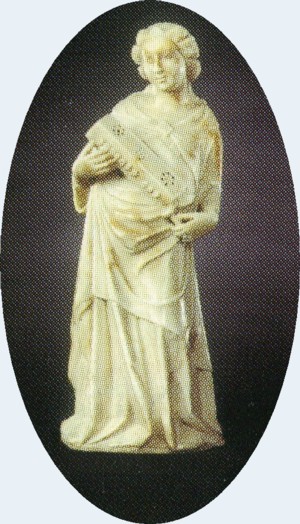
medieval.org
Leonarda LE 340
Recorded at Alice Barler Recital Hall, Wells College, Aurora, New York, September, 1994
released in 1997

medieval.org
Leonarda LE 340
Recorded at Alice Barler Recital Hall, Wells College, Aurora, New York,
September, 1994
released in 1997
Medieval Chant,
Songs, Dances
Beatriz, Countess de Dia · 12th c., France
01 - A Chantar [7:32]
soprano, medieval fiddle, lute
Maroie de Dregnau de Lille · 13th c., France
02 - Mout m'abelist quant je voir revenir [1:37]
soprano, psaltery, medieval fiddle
Queen Blanche · 1188-1252, France, b. Castile
03 - Amours, u trop tart me suis pris [4:26]
soprano, psaltery, medieval fiddle
anonymous · c.1400
04 - Trotto [1:23]
recorder, nakers
anonymous · 13th c.
05 - Estampie [1:25]
recorder, symphonia
Hildegard von Bingen · 1098-1170, Germany
06 - In Evangelium [1:51]
soprano, organetto
07 - O viridissima virga [4:32]
soprano, medieval fiddle, psaltery
08 - O Ierusalem, aurea civitas [7:17]
soprano, medieval fiddle, symphonia
anonymous · c.1400
09 - Saltarello [1:29]
recorder, lute
10 - Saltarello [1:54]
recorder, tambourine aux cordes
11 - La Manfredina [2:38]
medieval fiddle, lute
16th & 17th
Century Songs & Lute Duets
Anne Boleyn · 1507-1536, England
12 - O Deathe, rock me asleepe [7:08]
soprano, lute, bass viola da gamba
Lady Killigrew · 17th c., England / words, John Donne
13 - Sweetest love I do not goe [3:40]
soprano, lute, bass viola da gamba
Giles Farnaby · c.1563-1640, England
14 - Tower Hill [3:24]
two lutes
anonymous
15 - Green Sleeves [2:51]
two lutes
Mary Harvey, Lady Dering · 1629-1704, England
16 - When first I saw Fair Dorris' eyes [2:11]
17 - And is this all? What one poore kisse? [0:55]
18 - In vain fair Chloris, you design (words by Sir Edward
Dering) [2:58]
soprano, lute, bass viola da gamba
anonymous
19 - La Rosignoll (The Nightingale) [2:41]
two lutes
Richard Farnaby · b.1594, England
20 - Nobody's Gigge [2:27]
two lutes

Andrea Folan, Susan Sandman, Derwood Crock
Manuscripts of medieval songs contain only melody, with no
indication of instrumentation. The instruments chosen for this
recording were common in the 12th and 13th centuries. In keeping with
early practices in performance, the instrumentalists have added their
own countermelodies, ornamentation, and, where manuscripts are
ambiguous, rhythmic interpretation. The later songs are performed in
the English lute song style with voice, lute and bass viola da gamba.
Lute realizations for Lady Killigrew and the first two Harvey songs
were supplied by Dr. Sandman.
History has been unkind to the female composer. Until more
recent times, she seemed not to exist at all, as her compositions
sometimes appear under masculine pseudonyms or are claimed by husbands,
brothers, fathers, or other male contemporaries. The women represented
here, spanning the 12th through the 17th centuries in Europe, are
unique and lucky; their work has survived and is recognized.
Countess of Dia allows us a unique personal perspective of a
world ruled by a rigid code of courtly love. The text for this song is
outside the male, more formal, aesthetic of courtly love because of its
directness, immediacy and personal viewpoint. The Countess, wife of
Guilhèm de Poitiers, lived in southern France in the 12th
century, a period favorable for the economic independence of
aristocratic women. The legal system in southern France allowed women
to inherit property; they often ruled their family estates while their
husbands were away fighting in the crusades, freedoms that were
gradually whittled away in later centuries.
Although this was an era when poetry and music by women flourished,
there are only 23 surviving poems by women and only four melodies. We
are fortunate to have both the melody and poetic text for the Countess
of Dia's song, one of only two extant melodies of its kind surviving
from the 12th century.
Maroie de Dregnau de Lille (13th C. France) is an otherwise
unknown poet whose lovely little song presents us with a glimpse into
the secular life of medieval women — the expectation that despite
the chill of winter, a maid should remain joyful and thus increase her
worth.
Queen Blanche (1188-1252) was born in Castile, then a kingdom in
what is now central and northern Spain. Upon marriage, she became Queen
of France, and governed France as regent during the minorship of her
son Louis IX, and then again in his absence during the 7th crusade. Of
noble birth, Blanche was in the position to benefit from an education
otherwise unavailable to women, or to most men. Her nobility and its
accompanying education and wealth probably helped ensure the survival
of her song through the centuries.
Hildegard of Bingen (1098-1170), a unique and extraordinary
woman by any century's measure, wrote books on natural science,
theology and medicine, as well as the first morality play set to music.
She composed a large collection of religious music, Symphonia
armonie celestium revelationum (Symphony of the harmony of
celestial revelation). Of noble birth, her resources probably helped
her to found her own monastery in Germany, and she earned the respect
of kings, emperors and churchmen. The title of her collection,
"Symphonia," refers, in addition to its more general musical meaning,
to the medieval style hurdy-gurdy called a symphonia used in this
performance of O lerusalem. The songs in this collection are in
Latin, and, as common with plainsong, were written as a single line of
music. This performance includes echoes, counter-melodies and drones
inspired by Hildegard's melodies and poetry.
Several centuries of social, political, and artistic change are
reflected in the English compositions on this CD. Multi-part
compositions replace single-line melodies, the number of surviving
manuscripts increases, and a rising middle class encourages
music-making in the home.
O Deathe, rock me asleepe is attributed to Anne Boleyn
(1507-1536), the second wife of King Henry VIII and mother of Elizabeth
I. Anne's father attained a high position under the young Henry VIII
and spent several years as Ambassador to France. Anne lived at the
French court from age 12-16. We know she was trained in music and
dancing, owned a virginals (a keyboard instrument similar in sound to a
harpsichord), and played the lute. She had an excellent reputation as a
composer and performer. This song is said to have been written by her
when she was in the Tower of London facing execution for treason,
though her only crime was probably her failure to produce a male heir.
Lady Killigrew's lovely setting of this poem by John Donne
appears in an English manuscript from the early years of the 17th
century. Though her first name is not indicated and thus her exact
identity difficult to ascertain, she may be related to Anne Killigrew,
a poet and painter who lived just before the Restoration. The unclear
identity of Lady Killegrew is a good example of the dilemmas music
historians face when researching this material.
Giles Farnaby (c. 1563-1640) was a "joyner and musician" (a
woodworker, composer and music teacher) who earned a Bachelor of Music
from Oxford in 1592. More than fifty of his pieces are included in the Fitzwilliam
Virginal Book, a major collection of English keyboard music. We
included Farnaby's piece Tower Hill because it refers to the infamous
prison where Anne Boleyn was held prisoner earlier. We perform it on
two lutes instead of keyboard.
Richard Farnaby (b c. 1594-?), whose piece closes this
recording, was Giles' Farnaby's son. Less is known about Richard, but
four of his pieces are in the Fitzwilliam Virginal Book.
Anonymous Lute Duets are taken from the Jane Pickering Lute
Book (1615-1645), which contains music copied in three different
hands. It was customary at the time, when printed music was not so
readily available, to write down familiar tunes, one's own tunes, and
tunes composed by others. The anonymous lute duets on this recording
were copied in the same hand that wrote "Jane Pickeringe owe [sic]
this Booke 1616," presumably by Jane Pickering herself. Both the main
part of the Jane Pickering Lute Book and the Fitzwilliam
Virginal Book were written in the 17th century during the "Golden
Age" of Elizabethan and Jacobean lute music.
Mary Harvey, the Lady Dering (1629-1704) studied music at Mrs.
Salmon's School, a fashionable English girls' school where she also
learned Latin, French, "all manner of cookery," fancy needle work, and
dancing. After her marriage at age nineteen, she began lute lessons
with Henry Lawes, a composer at the court of Charles I. Three of Lady
Dering's songs were included in Lawes' publications of Jacobean lute
songs, and although the title page mentions only Lawes as composer,
Lady Dering's name appears on the music itself. The text for the last
song is by Sir Edward Dering.
—Susan G. Sandman

Elizabethan Corversation was founded in 1982 as a lute duet
specializing in the music of Shakespeare's time. The ensemble now
performs various repertoires.
Susan G. Sandman is an early music performer and musicologist
who received her B.A. in music from Vassar College and a Ph.D in
musicology from Stanford University. A Professor of Music at Wells
College in New York's Finger Lakes region, she teaches music history
courses and directs the Wells Consort, a student group that performs on
period instruments. Dr. Sandman is published in journals in the areas
of early music and women composers, and researches the music for
ELIZABETHAN CONVERSATION.
Derwood Crocker began private music study in early childhood.
His skills in design and traditional woodworking led to the making of
musical instruments, and he has been a full-time craftsman/musician
since 1965. The Crocker workshop has produced hundreds of instruments
for performers and ensembles nationwide, many of them one of a kind.
His instruments are in the collections of numerous colleges and at the
Museum of Fine Arts in Boston. He performs in ELIZABETHAN CONVERSATION
and lectures on the history and making of early instruments at
workshops and seminars.
Soprano Andrea Folan earned degrees in voice and German from
the Oberlin Conservatory and College and did graduate work in
performance practice at the Mannes College of Music in New York. Her
special interest in the German Lied repertoire with fortepiano has led
to extensive performances in the U.S. and abroad with acclaimed
fortepianists, including Malcolm Bilson, in recital series and at
festivals, including Festival Flanders (Brugge, Belgium) and the Boston
Early Music Festival. Andrea recently released a solo CD of Haydn songs
with fortepiano to critical acclaim. Her early music credentials
include performances with the Folger Consort and Apollo's Fire, among
others. She is a founding member of The Public Music and is also an
active oratorio specialist. She maintains a private voice studio in
addition to her duties as a vocal coach at Cornell University.

Pictured, bottom, then clockwise:
symphonia, medieval fiddle, recorders, organetto, bass viola da gamba,
psaltery, lutes.
Not pictured: nakers (a hand drum from the Middle East), traditional.
Performances:
Susan Sandman: medieval fiddle, recorders, lute, bass viola da gamba.
Derwood Crocker: lute, psaltery, synnphonia, organetto, nakers.
Instrument makers:
Symphonia, medieval fiddle, organetto, and top lute made by Derwood
Crocker.
Other lute by Middleton.
Recorders by Bob Marvin.
Bass viola da gamba by an anonymous Swiss maker, 1970.
Music Sources
Dia: Paris, Bibliothèque nationale, MS Fr. 844, Fol. 204R.
de Lille: Le Manuscrit du Roi.
Queen Blanche: Paris, Bibliothèque nationale, MS f.fr.
21677.
Hildegard: Dendermonde Codex. This recorded performance omits
verses 4 and 6 in "O lerusalem."
Boleyn can be found in Briscoe, ed. Historical Anthology of
Music by Women (1987).
Killigrew: Oxford Tenbury MS 1018; ornamented version from
Bodelian Library. Add. 10337 fol. 55v.
Harvey: Henry Lawes' Second Book of Select Ayres and
Dialogues (John Playford, 1655).
Anonymous lute duets: The Jane Pickering Lute Book
(1615-1645) and Folger MS 1610.
Farnabys: Fitzwilliam Virginal Book. Lute realizations
for "Sweetest love I do not goe, When first I saw Fair Dorris' eyes,"
and "And is this all? What one poor Kisse?" were supplied by Dr.
Sandman.
"In vain, fair Chloris" is published in "English Songs," Musica
Britannica, Vol. 33, ed. Ian Spink (London. Stainer & Bell,
Ltd. 1971).
Text Sources
Dia original text from Meg Bogin, The Women Troubadours
(NY: Paddington Press/Two Continents Publishing Group, 1976).
Translation: Women in Music: An Anthology of Source Readings from
the Middle Ages to the Present, ed. Carol Neuls-Bates (NY: Harper
& Row, 1982).
de Lille: "Mout m'abelist": Maria V. Coldwell, Jougleresses
and Trobairitz: Secular Musicians in Medieval France, in Women
Making Music: The Western Art Tradition, 1150-1950, ed. Jane Bowers
and Judith Tick. (Urbana: University of Illinois Press, 1986), p. 52.
Visual
Representations of Women in the Middle Ages
Cover art: "Angel with Symphonia," c. 1360, possibly Pisan. Samuel H.
Kress Collection, ©1966 Board of Trustees, National Gallery of
Art, Washington D.C.
A good source for pictures of 15th C. women musicians and artists is The
Medieval Woman, An Illuminated Book of Days, ed. Sally Fox.
(Boston: Little, Brown and Company, 1985).
